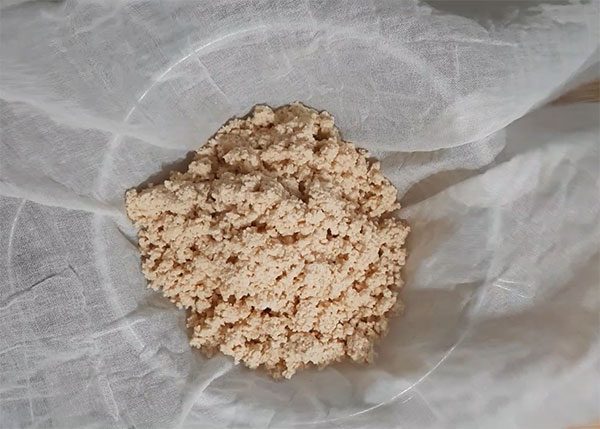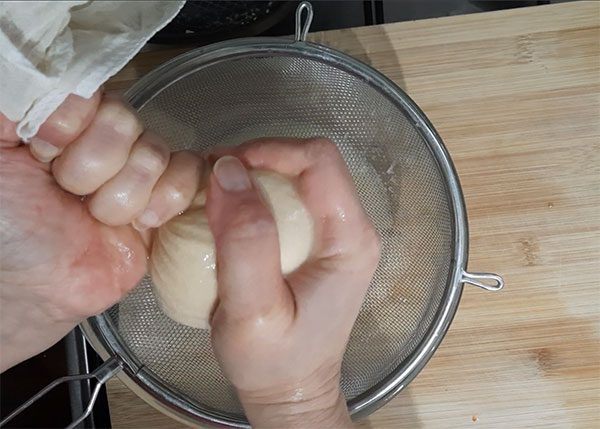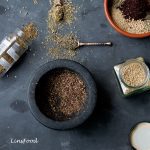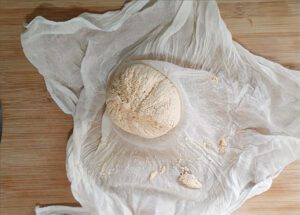This homemade kashk recipe is going to be your next best friend, allowing you to make countless Persian and other Middle Eastern dishes that call for it.
Estimated reading time: 6 minutes

What is Kashk?
Kashk in English, to put it in the simplest terms, is fermented yoghurt. It’s creamy, tangy and is rich in umami notes, a little like goat’s cheese. It is a much loved ingredient not just in Iran, but also the surrounding region, across the Middle East, Central Asia and The Balkans.
You will also find kashk sold as dried fermented discs, in many of these places. These discs are ground and mixed with water before being used.
These are some of the names that kashk is also known as:
- jameed
- kurut
- kishk
- chortan
- tarhana
The production methods and presentations may differ but all the dairy based ones can be used interchangeably in recipes that call for any one of them.
What is Kashk made of?
Kashk is what it’s called in Iran, and in ancient times, many food historians believed it was made using fermented grains. Somewhere along the lines, milk was added to the process and until today, this fermented product can be made with either or a combination of the two.
Fast forward a few hundred years, and the Iranian kashk was made using doogh, a by-product of making yoghurt butter. If you like, you can read more about that, and get the recipe for for doogh here.

Homemade Jameed
Homemade kashk or jameed is so much better than anything you can buy in a carton. It has a fresher flavour and is much closer to a traditionally made version.
You can easily make kashk at home with yoghurt, water and a little salt. This is what we’ll be doing:
- Leave the yoghurt out at room temperature for 2 days in a glass container, to allow it to sour.
- Simmer the yoghurt and water for about 2 hours. It will split into curds and whey at this point. The whey is then cooked off, leaving behind the curds.
- Drain the curds to get rid of excess moisture.
- At this point, you can mix it with water and salt (in a blender) and use as required, or store as is.
Homemade Kashk in Photos










How long does Homemade Jameed Last?
Homemade jameed or kashk will keep in the fridge for a week, whether stored in its reduced form or after blending with water and salt.
How much water you use to blend homemade jameed depends on your recipe. Some may call for a runny kashk, while others will require a thick dollop, especially when used as a garnish.
You can also freeze it. Again, you can do this before or after blending it with water. My preferred way is to freeze it in its grain form, in ice cube trays, as you can see in the image. That way, I can use as much or as little as I need, without any leftover waste.
How to use Kashk?
No matter what we call it, we use kashk in very similar ways:
- as a garnish or topping
- to thicken soups and stews
- in marinades
- as a flavour enhancer
In some ways, kashk is used as you would use soured cream or crème fraîche in savoury recipes.
Kashk Substitute
If you desperately need to have some kashk or jameed and don’t have the time to make it, here’s a good substitute.
You can use the same amount of crème fraîche or soured cream as the recipe calls for but grate in a tiny amount of goats cheese or parmesan to up the umami factor. Say about 1-2 tablespoons of cheese for every measuring cup of kashk (metric – a cup that takes 250ml liquid).
Look out for recipes over the coming weeks that use kashk or jameed as it’s also called.
And now, let’s get our aprons on.
If you enjoy the recipe, drop me a comment and let me know. And if you’re feeling like a star, don’t forget that 5-star rating! Merci!
If you make this recipe, post it on Instagram and tag me @azlinbloor.
Lin xx
More Middle Eastern Ingredients




Homemade Kashk Recipe (aka Jameed, Kurut)
Equipment
- 1 large glass bowl
- 1 large saucepan
- 1 ladle
- 1 Large sieve
- 1 muslin or cheesecloth (click to see the one I use, from Amazon)
- blender or chopper
- container/ice cube tray to store
Ingredients
- 900 g full fat Greek yoghurt this is 2 tubs of 450g in the UK
- 1 litre water
- ½ – 1 tsp salt this is only for blending
Instructions
Two Days Before
- Pour the yoghurt into a large glass bowl and cover it with a kitchen paper or clean tea towel. We want it to breathe, so not clingfilm.Leave out on the kitchen counter, at room temperature for 2 days. This is going to allow the yoghurt to take on a more sour taste, making our kashk even closer in flavour to traditionally made ones.

Day of Cooking (Day 3)
Making the Kashk
- Pour the yoghurt and water into a thick based saucepan and bring to a simmer on medium heat.

- Reduce the heat to medium-low and leave to simmer for about 2 – 2½ hours, stirring about 2-3 times.Your mixture will start to separate into curds and whey, and reduce.

Draining the Kashk
- Wash and dry the large bowl you used earlier and top it with a muslin covered sieve. Double the muslin if it's too thin.

- Pour the dry-ish kashk grains onto the muslin to drain.

- Now wait for it to cool down to touch, so you don't burn your hands. Gather the corners of the muslin and wrap the kashk up and squeeze the excess whey off.

- Hang the muslin wrapped kashk to drain. I do it over the sink, on my tap.

Transforming Dry Kashk to Liquid Kashk
- Unwrap the kashk and gently crumble it. Depending on how dry it is, it may be quite hard, so give it a knock with the back of a knife to loosen it first.

- To transform this dried kashk grains into liquid, add enough water and salt to get a creamy, tangy liquid. How much you use depends on the recipe it's for. Start with a pinch of salt if making a small amount, and work your way up.

To Store Homemade Kashk
- This liquid kashk can now be frozen for up to 3 months or kept in the fridge for a week. Use any freezer proof container, I love ice cube trays for this.

- I also freeze just the grains in ice cube trays. Wrap tightly with cling flim, and freeze for up to 3 months.To use the frozen kashk, just defrost for an hour, depending on the amount.

